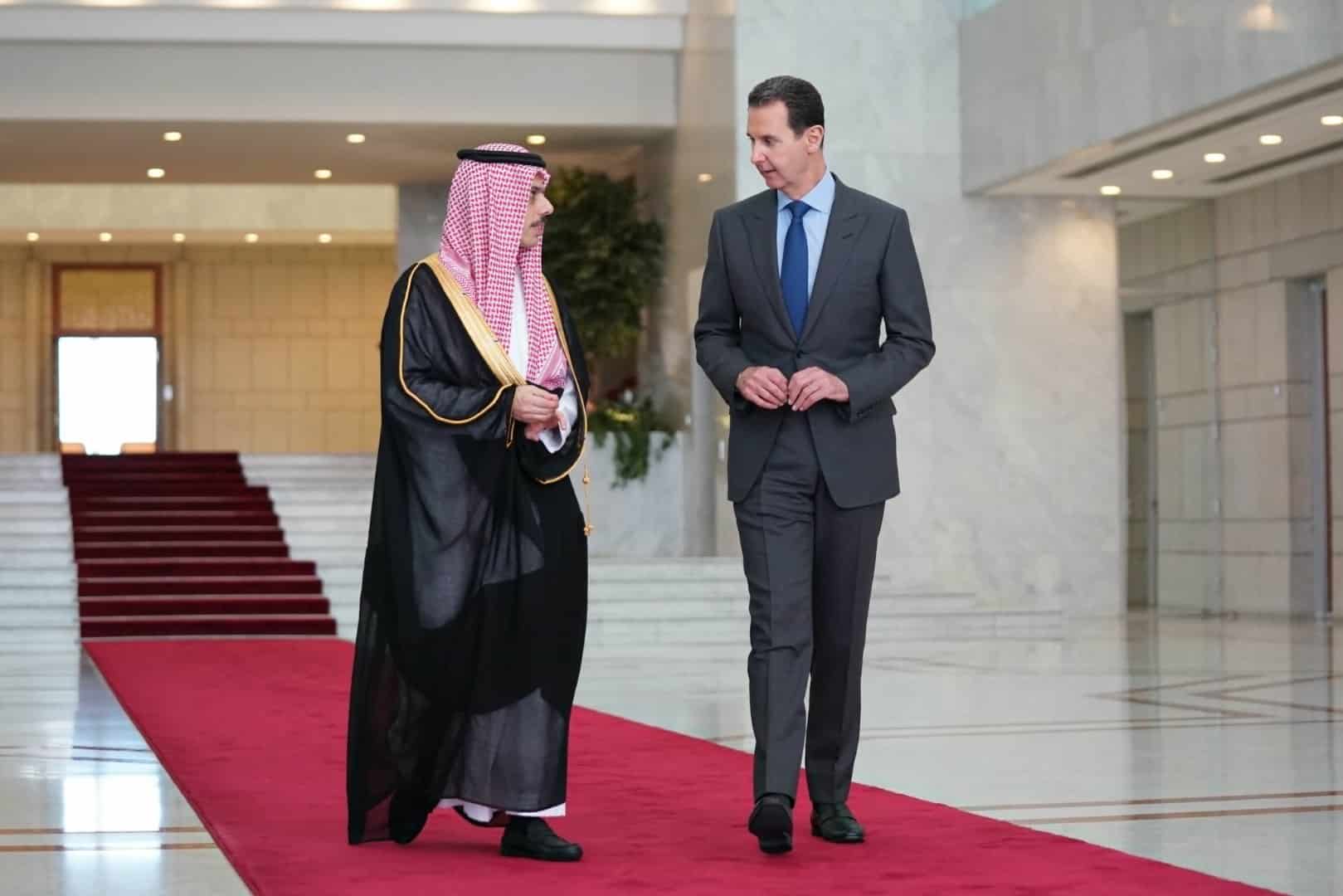
While the world continues to come to grips with the reality — and consequences — of the Chinese-brokered rapprochement between Saudi Araba and Iran, another diplomatic coup is unfolding in the Middle East.
This one is orchestrated by the Russians. Saudi Foreign Minister Prince Faisal bin Farhan flew to Damascus last week, where he met Syrian President Bashar Assad. This visit followed that of Syrian Foreign Minister Faisal Mikdad earlier this month to Riyadh.
The two countries severed diplomatic relations in 2012 at the beginning of a Syrian civil conflict that saw Saudi Arabia throwing its money behind anti-regime fighters seeking to remove Assad from power.
The startling diplomatic about face is part of a new Saudi Arabian foreign policy, embodied in its historic new relationship with Iran, which seeks to engender regional stability through conflict resolution instead of military-brokered containment.
As the Saudi Foreign Ministry noted on bin Farhan’s visit to Damascus, the Saudi goal is “to reach a political solution to the Syrian crisis that would end all its repercussions and preserve Syria’s unity, security, stability, and Arab identity and restore it to its Arab surroundings.”
Dramatic Outbreak of Diplomacy
The dramatic outbreak of diplomacy between Riyadh and Damascus is the by-product of Russia’s growing influence in Middle Eastern affairs and is one of the clearest signals yet of the declining role of the United States, whose military and diplomatic posture in the region has greatly diminished over the course of the past few years.
Russia has long-standing ties with the Syrian government. In 2015, its intervention during Syria’s civil conflict upheld the Assad government, allowing it to regain the initiative against the US-and Saudi-backed opposition.
Russia’s relationship with Saudi Arabia, however, was more complex, with the Saudis having strategically aligned themselves with US foreign and national security objectives in the Middle East and in global energy policies.
But that dynamic changed after October 2018, when Saudi security agents, alleged to have been working under the direct orders of Saudi Crown Prince Mohammad bin Salman, murdered Saudi dissident journalist Jamal Khashoggi.
The Saudis took umbrage at the US outcry at the crime, especially when then-presidential candidate Joe Biden threatened the crown prince, popularly known as MbS, with isolation and punishment.
“We were going to in fact make them pay the price, and make them in fact the pariah that they are,” Biden said during a televised debate in November 2019, adding that there is “very little social redeeming value in the present government in Saudi Arabia.”
Biden was later to regret those words when, in July 2022, he was compelled to fly to Saudi Arabia and ask MbS to increase oil production to lower energy costs that had skyrocketed because of the consequences of US-led efforts to sanction Russian oil and gas in the aftermath of the Russian invasion of Ukraine in February 2022.
While MbS received Biden, the US did not get the results it wanted from the meeting for reasons that went beyond poor personal chemistry between MbS and Biden. By then, both Saudi Arabia and Russia recognized that, as major oil producers, their interests were not well served by competing in a market dominated by US-driven angst.
This realization matured in the spring of 2020 in the aftermath of an “oil war” between the two nations which saw Saudi Arabia precipitously lower the price of oil by overproducing, only to be matched by Russia.
The Saudi-Russian oil war ended because of negotiations brokered by then-President Donald Trump and for a while the world was compelled to live in an environment where the top three oil producers — the US, Russia and Saudi Arabia — openly colluded on global production quotas.
But then came the Russian invasion of Ukraine, US-led energy sanctions and the recognition by both Russia and Saudi Arabia that the US was not a stable partner when it came to managing the most important economic resource of their nations — energy.
US-Saudi Relations Strained
As Russia-Saudi bonds grew stronger based upon shared goals and objectives, the strain between Saudi Arabia and the US likewise grew, driven by the total disconnect that existed between the Biden administration and MbS over Middle East policy.
Saudi Arabia has embarked on an ambitious project, Vision 2030, which seeks to transition the oil-rich kingdom away from its current over-reliance on energy production to a more diversified economy based upon modern technologies and non-energy economic initiatives.
A key prerequisite for this vision is for Saudi Arabia to become a force of connectivity in the region and the world — something that US-driven policies promoting regional instability and war made impossible. The Biden administration had doubled down on a policy in which Saudi Arabia served as the keystone in confronting Iran along an arc of crisis stretching from Lebanon, through Syria and Iraq; and into Yemen.
Saudi Arabia confronted the reality that it could not win its war in Yemen (ongoing since 2014), and that the US-led destabilization efforts in Lebanon, Syria and Iraq were floundering. With its own economic diversification goal in mind, it opted to work with Russia to engender the kind of stability needed for energy-driven economies to flourish.
Russia quietly organized talks with both Saudi and Syrian officials and diplomats, culminating with the March 2023 visit of President Assad to Moscow, where the issue of a rapprochement with Saudi Arabia was finalized.
Work remains to be done, however, as Saudi Arabia’s effort to bring Syria back into the ranks of the Arab League faces resistance from staunch US allies Jordan, Kuwait and Qatar. But the fact is that, thanks to Russian and Chinese diplomacy, peace, not war, is breaking out all over in the Middle East. Bringing Syria in from the cold is simply the most recent manifestation of the phenomena.
Reprinted with author’s permission from ConsortiumNews.com.

